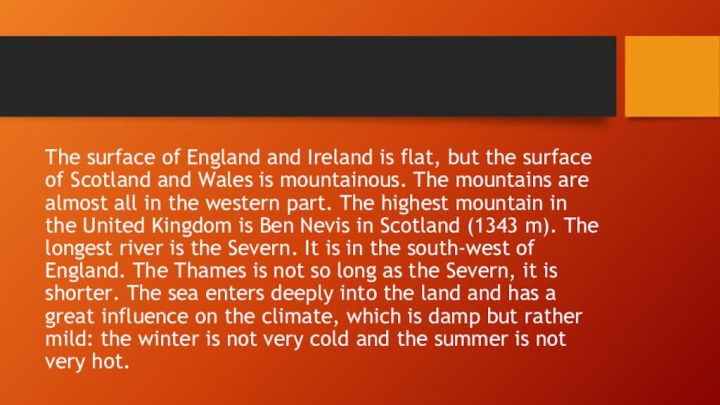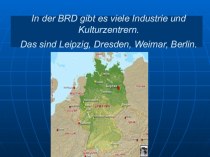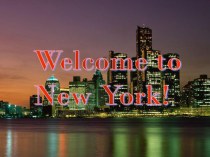Слайд 2
The British Isles lie in the north-west of
Europe. They consist of two large islands, Great Britain
and Ireland, and many smaller ones. Great Britain, the largest island in Europe, includes England, Scotland, and Wales. It is separated from Ireland by the Irish Sea, and from the Continent by the English Channel and the Straits of Dover. Great Britain and Northern Ireland form the United Kingdom (UK).
Слайд 3
The surface of England and Ireland is flat,
but the surface of Scotland and Wales is mountainous.
The mountains are almost all in the western part. The highest mountain in the United Kingdom is Ben Nevis in Scotland (1343 m). The longest river is the Severn. It is in the south-west of England. The Thames is not so long as the Severn, it is shorter. The sea enters deeply into the land and has a great influence on the climate, which is damp but rather mild: the winter is not very cold and the summer is not very hot.
Слайд 4
Over 57 million people live in the United
Kingdom. Most of the people of Great Britain live
in big towns and cities.
The capital of the country is London. The main industrial centres are Sheffield and Birmingham where iron goods are made, Manchester, the cotton centre of England, and others.
The important ports of the country are London, Liverpool, Glasgow and others.
Слайд 5
London is the capital of England, the capital
of Great Britain, and the capital of the United
Kingdom. It is the largest town in Europe and one of the oldest towns in the world. The old Celts gave it its name, the Romans! made it the centre of their new colony, the Germanic invaders tried to burn and to destroy it, the victorious Normans made it the capital of the country.
The central part of London is full of historical remains. Nearly every building, every bridge, every street, palace, house, and stone — each of them has its own story, its own past. In London past and present are so mixed together that they cannot easily be separated and when you are in London you see the past in the present and the present in the past.
The oldest part of London is called the City. In the City the streets and pavements are very narrow and the traffic is very heavy on weekdays. That is because the most important London firms and banks have offices there. But at weekends the City is almost dead.
Слайд 6
The most fashionable and the most expensive part
to live in is the West End. It is
situated between the City and Hyde Park. The City and the West End are the heart of London; they are the parts which everybody who comes to London must see and wants to see, because they are more interesting than any other part of London. All the most interesting buildings, shops and offices are situated here.
The Tower of London, the Bank of England, the Mansion House where the Lord Mayor lives, the Law Courts, and many interesting old churches are situated in the City. The Houses of Parliament with Big Ben, Westminster Abbey, the National Gallery and many theatres and good shops are in the West End.
London has many bridges over the Thames, more than twenty but the most interesting of them all is the Tower Bridge situated near the Tower of London.
Слайд 7
The Tower of London is an old castle,
with high walls, high towers, small windows and large
gardens. Once it was a royal residence, a strong fortress and a state prison. Here many important people, among them two wives of Henry VIII, were imprisoned and beheaded.
One of the oldest and the most famous places of London is St. Paul's Cathedral. It has been destroyed and rebuilt several times since the original construction in the 7th century. It stands in the centre of the so-called Little Britain. A large part of Little Britain was destroyed during the war: the houses that were close to the Cathedral's walls disappeared and for the first time in centuries St. Paul's Cathedral's beauty can be seen.
Слайд 8
The big clock on the tower of the
Palace of Westminster in London is often called Big
Ben. But Big Ben is really the bell of the clock. It is the biggest clock bell in Britain. It weighs 13.5 tons.
The clock tower is 318 feet high. You have to go up 374 steps to reach the top. So the clock looks small from the pavement below the tower.
Слайд 9
But its face is 23 feet wide. It
would only just fit into some classrooms.
The minute-hand is
14 feet long. Its weight is equal to that of two bags of coal. The hour-hand is 9 feet long.
The clock bell is called Big Ben after Sir Benjamin Hall. He had the job to see that the bell was put up.
Sir Benjamin was a big man. One day he said in Parliament, "Shall we call the bell St. Stephen's?" St. Stephen's is the name of the tower.
But someone said for a joke, "Why not call it Big Ben?" Now the bell is known all over the world by that name.
Слайд 10
The British Museum has one of the largest
libraries in the world. It has a copy of
every book that is printed in the English language, so that there are more than six million books there. They receive nearly two thousand books and papers daily.
The British Museum Library has a very big collection of printed books and manuscripts, both old and new. You can see beautifully illustrated old manuscripts which they keep in glass cases.
Слайд 11
You can also find there some of the
first English books printed by Caxton. Caxton was a
printer who lived in the fifteenth century. He made the first printing-press in England.
In the reading-room of the British Museum many famous men have read and studied.
Charles Dickens, a very popular English writer and the author of 'David Copperfield', 'Oliver Twist', 'Dombey and Son' and other books, spent a lot of time in the British Museum Library.










































